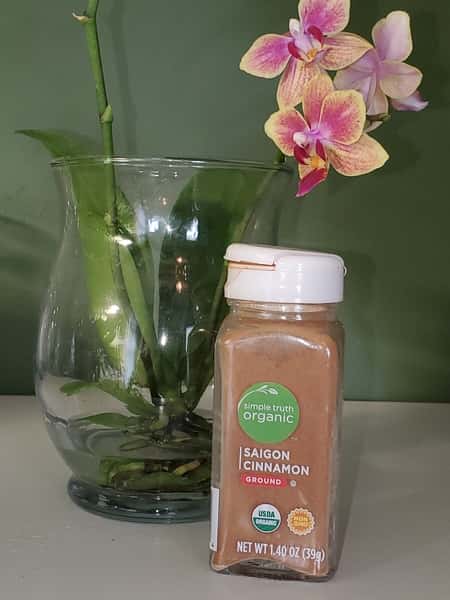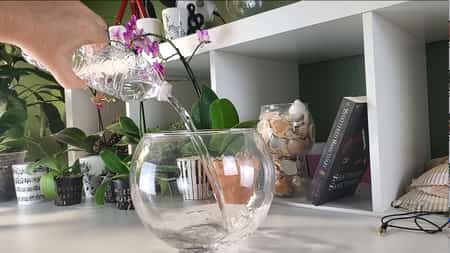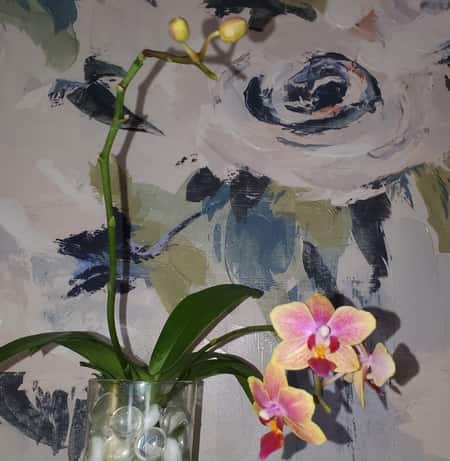Transferring your orchid to water culture can be a solution to minimize problems down the line when growing orchids. For new orchid growers, it can be a good solution if (and only if) you follow the guidelines. One mistake in the procedure can set your orchid down a death path, since the only variable you have to work with is the water.
How do you transfer an orchid from sphagnum moss or bark into full water culture?
First, you’ll need to chose the most appropriate time to do the transfer. Repotting an orchid during the wrong time can kill it, even more, changing its potting medium entirely.
Second, you’ll need to verify the roots, cleaning out any old potting material. And finally, you’ll need to verify the correct method and water to use for full water culture.
Let’s look at those step by step.

The difference between full water culture and semi water culture
Before you transfer your orchid into full water culture, there are a few differences in full and semi water culture.
Both full and semi water cultures consist of having the orchid in a vase with no potting medium whatsoever.
The only medium will be air and water.
The difference is that in full water culture, the orchid will sit in a little water for 5 days, and no water for 2 days. The emphasis here is on a little. Maybe one root or two is actually soaking in the water. The water sits constantly in the bottom of the glass vase, which is actually good for raising humidity.
The bad side is that you’ll have to clean the vases out more often, since algae and bacteria can build up.
Semi-water culture is where the you’ll fill water up to 2/3 the height of the roots, almost to the top of the pot, and let it soak for 2 days. To get on a schedule, let’s say you decide to do this Monday morning. Tuesday night, you’ll daring all the water out. The orchid then sits in the empty pot with no water, drying out for 5 days. This completes the week’s cycle.
Both methods have a drying out period, so your orchid will not sit the entire time in water. To decide which method is better, you’ll need to test your orchid. This article only focuses on Full Water Culture.
Choose the Correct Time to Transfer to Full Water Culture
Full water culture is an option that has had some success, and is a sworn method for some orchid growers. It’s not suited for all orchids, though.
Even if you follow all the steps, some orchids just refuse to grow in full water culture, so don’t blame yourself if by chance your orchid chooses to give up. To minimize the chances of this happening, you need to chose the best time to transfer your orchid to full water culture.
It won’t be the best time for you, but for your orchid. They always come first. So be patient, waiting for all the flowers to finish their blossoming cycle. Some orchids will go into a dormancy period, which is the perfect time for a transfer. Don’t be too patient though… When you see new roots appearing, then you’re running out of time to transfer, so act quickly.
Transfer it as soon as the blooms fall off
When you first buy an orchid, it most probably will come in pure sphagnum moss as its potting medium. A more reputable grower or nursery will have better potting media, but the majority will be in sphagnum. Get this yucky stuff out as soon as possible. This media (by itself) is not suited for home environments and will accumulate mold, not air out properly, and cause root rot.
Image Credit: © 2020 Orchideria. All Rights Reserved.

There are some orchid designs that I use pure moss, like this one for Kokedama.
That’s a Japanese design where the orchid pot is substituted for a moss ball. But if the roots sit in a pot, then pure moss will not be the best potting medium.
Even repotting into the same medium takes a hit on orchids. For example, cymbidiums hate to be repotted and can react negatively during that period after a repot.
So, imagine taking a double hit: repotting and changing the type of medium.
By the way, if you want to learn how to make a kokedama, click here.
Transfer it as soon as you bring it home
You can transfer the orchid in to full water culture as soon as you bring it home, even if it is in blossom. I would personally wait for the flowers to fall, but you can repot it now.
This timing has a positive side to it: you can see first-hand how the roots are, what the growing conditions are, and what problems might be present before placing the orchid next to others in your collection.
All other times to transfer your orchid to water culture will not bring positive results. So stick to these two factors.
Another point to consider is that if you have cultivated an orchid for a couple of years in orchid bark, perlite, charcoal and more traditional potting media, and later decide to transfer it to full water culture, your orchid has a high probability of dying.
Try to transfer orchids as soon as you first get them or right after the flowers fall off.
Clean the root system for good Full Water Culture Results
Here’s another big point in full water culture. Since the roots will be in water (at least a few of them) for a good period of time, then there can be absolutely NO old potting medium left on the roots.
When you clean out the roots, you’ll have to be patient and really clean. Any old bark, slithers of sphagnum moss, perlite, or any other material that is left attached to the orchid roots will rot in the new potting medium.
This is actually worse with semi-hydroponics, since the majority of the roots sit two days in water. But it still affects full hydroponics, too. Don’t let the orchids suffer any more than absolutely necessary. Make sure the roots are spotless when it comes to removing old media.
Cut any old roots off. Don’t be shy about this part. Old roots are just a cluster of bacteria waiting to take over. It’s better to cut it off than to risk contaminating the rest of the roots. In water culture, bacteria will one of the biggest hazards. All the old roots will die eventually in the new medium, so I see this step as just a head’s start.
In full water culture, it’s better to have less roots that are firm, healthy, and performing their functions well, than more roots but in bad shape, that demand more of the orchid’s energy.
Choosing the right water for Full Water Culture

Since you are substituting the potting medium entirely for water, the type of water you use will greatly influence the orchid’s life.
There are no shortcuts here, and using had water (full of added chemicals and overloading on chemical substances) can harm your orchid beyond repair.
In this article, I explained the difference between hard water, soft water, distilled water, rain water, and reverse osmosis water. It has a definition of each and how to adapt the water you use to best you’re your orchid. But if you are using the full hydroponic method, you can’t simply adapt bad water.
You don’t have that privilege, and you’ll have to go with distilled water. Buy 10-gallon jugs of distilled water to hydrate orchids does come at an expense, but if done correctly, it’s well worth it.
Even though you are using distilled water, you’ll need to check the pH. Water quality is important, pH even more so when using full hydroponics. Each orchid has a specific pH that they thrive in, but the vast majority will grow well from 5.6 to 6.5. Terrestrial orchids differ, preferring a more alkaline water, but the rest like more acidic.
This makes a huge difference in full hydroponics. Don’t cut the edges and use tap water.
What to expect the first few days from Full Water Culture
Your orchid has been successfully transferred into full hydroponics. Now, for the first few days, expect the worst. I know… Not the answer you expected. But it’s true.
The old roots will die off, since they were born to adapt into sphagnum moss or bark. This new form of watering will be a complete shock to them, and they won’t be adapted to absorb nutrients as well as new roots. The orchid will sense this change, and produce new roots.
New root: this is the second sign that you’ve done the transfer properly. The new roots will grow and enter the water culture, adapted to this new medium. They’ll have a better chance at surviving, since they will have adapted when young and tender.
(Yeah, don’t even get me started on adapting at mid-life to new surroundings and situations…Nothing brings on a mid-life crisis more than that. If you need some inspiration for getting through a mid-life crisis, check out my ABOUT page. I went from Brazil to Kansas after being 38 years overseas… )
It might so be that a leaf will turn yellow and drop. This, again, is the orchid adapting to its new potting medium and trying to figure out the best way to converse energy will it’s producing new roots. Since the older roots are practically inefficient in absorbing water and nutrients trough this new medium, your orchid will be depraved of nutrients until its new roots are grown.
It has to use its energy wisely. This is why it’s not a god idea to transfer to full water culture while in full bloom. Sympodials are a little more successful at this than monopodials, since the pseudobulb will have a bigger reservoir of nutrients.
Fertilizer is extremely important in full water culture
Since you will be taking away all the other potting media, and leaving the orchid with only water to find its nutrients, you have to be on par with fertilizing techniques.
The orchid will need to be fertilized weekly, weakly, but if you have the water in the vase for five days, how does that work?
Fertilization will be different with water culture. You can’t squirt a week dose of fertilizer in the vase and keep it there for five days. This will case root burn.
Instead, you need to apply fertilizer to your distilled water, and let the roots soak in this for 10 minutes. Then change the water. Don’t fertilize with the first water after the drying put days, either. This will also cause root burn.
Let the orchids soak in the water for a few minutes, change the water, add the fertilizer, let it soak, change the water, and this final water is what it will sit in for 5 days.
If you want to know what fertilizer to use or what additional products to add, you can download this 14-page fertilization guide. (In return, I ask that you subscribe to the website, but that, of course, is entirely optional.)Once you’ve set up your orchid in full hydroponics, the expectations are that its growth and health sky rocket. But that doesn’t always happen.
As it loses its roots, one by one, and new roots are forming, there just might not be enough energy for the orchid to make it. The leaves could wither, turn yellow, and fall off. The roots might turn brown and die. The flower spike loses it’s buds….
Things are starting to look bleak.
Is my orchid at risk of dying? Uhmmm… yes. There always is that risk. So, start out with an orchid that you like, but won’t miss if full water culture happens to make your orchid bite the dust.
Don’t start full water culture with your favorite orchid. At least with this advice, you’re headed in the right direction. But know that orchids can differ even from one to another in the same species. One might adapt perfectly and grow twice it’s size. Another one might give up and die.
Cultivating orchids is truly a trial an error experience. In this sense, writing guides like this one always makes me a little nervous. I’ve tried to be unbiased and leave my personal experience out of it, so I hope it didn’t show up too much. 😊 If you can’t tell, I prefer the traditional orchid bark, sphagnum moss, charcoal, and perlite…but that’s me.

What can work for you may not work for someone else. There are orchid growers who absolutely love full hydroponics, and other growers who detest this method. There will be people who will disagree with every word I’ve written, and other who will absolutely love it.
Don’t be influenced by what other people say. You need to find a method of growing orchids that fits you.
Test what works for you, in your environment, schedule, routine, and growing conditions. What works for you might not be what most recommend. Don’t let that bother you. Test, retest, and find the best growing conditions that work for your orchids.
After all, they are your orchids. If it’s water culture, then go for it. Dedicate yourself to learning more and more about it, and watch your orchids take off (in a good way).
Don’t Stop Learning!
If you want to be included in more information and get a 14-page fertilization guide, please sign up for my newsletter. I don’t spam, but send emails out bi-monthly with some curious topics of interest. If you want more information, click here to go to a specific page on this website where I explain it more in detail.

Also, if you are looking for an orchid journal to keep your notes specifically about orchid care, check out my 2 solutions for that on this page. If note-keeping isn’t your thing, then there is a free excel spreadsheet that you can download. Click here for more information on how to do that.
If you subscribe to my newsletter, I will send you a 14-page guide on the main tips of orchid fertilizer. It is downloadable and you can print it out on your computer. I designed the guide to double up as a coloring book, just to make it fun.
Happy Cultivating!


I want to learn more about water cultivated orchids. I don’t know how to subscribe to your webpage. I just started my water cultivation on my 5 orchids. They are doing well so I ordered some liquid seaweed but I’m not sure how to give them nutrients. I need help!